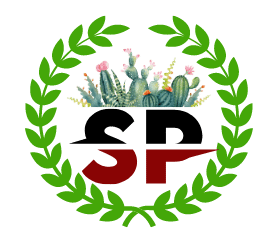Introduction
Alligator plant is a special undemanding and low- maintenance house plant admired for its unique foliage beauty. These succulents have long, thick and serrated dandy green leaves with small spurs along its phylloclade that can grow into the plantlets, with purple coloring underneath. The Alligator plant has a cylindrical unbranched stem which can grow up to 3 ft. or 1m tall.

Alligator plant produces bell shaped pinkish-grey or orange flowers in its blooming period mostly during warm weather in winter only when grown outdoors. They are tropical, evergreen, perennial versatile succulent grown outdoors as well as indoors. When planted outdoors, it is brought indoors in case of intense heat. It is placed in areas with ample sunlight. Alligator plant is one of the poisonous succulent native to Madagascar, Africa. The plantlets on its margins are viable and are easily blown away. It is a highly invasive species due to which it can take over your large garden space. So, its pot is kept far from one another.
Alligator plants are botanically named as Kalanchoe daigremontiana ( Previously called Bryophyllum daigremontianum). Because of its exceptional appearance, it is known by other common names like Devil’s Backbone, Mother of Thousands, Crown of Thorns or Mexican Hat. It is grown in USDA hardiness zone 9 to 11. It takes 2 to 5 years for this plant to mature.
Alligator plant is a drought tolerant plant. However, its soil needs to be kept moist for its proper growth. The propagation of this succulent is carried out through their plantlets on the leaves which is easier than anything. One plant can spawn thousands of babies which totally justifies their nickname Mother of Thousands.
Other Varieties of Mother of Thousands includes:
Bryophyllum delagoense (Kalanchoe delagoensis)
Bryophyllum х houghtonii (Kalanchoe х houghtonii)
Bryophyllum pinnatum (Kalanchoe pinnata)
Bryophyllum fedtschenkoi (Kalanchoe fedtschenkoi)
Bryophyllum gastonis-bonnieri (Kalanchoe gastonis-bonnieri)
Kalanchoe x laetivirens
Kalanchoe tubiflora
Is It Toxic?
The answer is a big Yes!. It produces a toxic steroid called daigremontianin, ingesting which can lead to gastrointestinal issues and even severe side effects like heart palpitations, tremors and seizures when consumed in large amounts. The toxic dose was 8–12g /kg b. w. (Williams and Smith 1984) and Dogs are reported to be particularly sensitive to the cardiotoxic effects of Kalanchoe. So, it should be kept far out of reach from children and pets. They should be taken to the poison control department immediately if its leaves are consumed.
Also Read:
Alocasia Sinuata: Care And Propagation
Crassula Capitella: Care And Propagation
Botanical Classification Of Alligator Plant
Kingdom: Plantae
Clade: Tracheophytes
Clade: Angiosperms
Clade: Eudicots
Order: Saxifragales
Family: Crassulaceae
Genus: Kalanchoe
Species: daigremontiana
Care
Alligator plant is a low maintenance succulent. So, it’s easy to take care of, cool and fun to grow. But, they need a lot more attention and more water than other succulents.
Light
Alligator plants are succulents and can be grown both in partial shade and full sunlight. It grows vigorously in 5-6 hours of indirect sun. It prefers morning sunlight and appreciates several hours of indirect light. However, intense light can lead to leaf scorch. Its leaves become leggy on prolonged exposure to bright sunlight. So, it’s better to keep them in indirect light. It is kept in a windowsill area or bright spot area with ample indirect sunlight. The light rays create a pretty leaf pattern.
Temperature
It prefers temperatures from 65 to 75 degrees Fahrenheit. It can’t stand the temperatures below 40 degree Fahrenheit. So, it is taken inside during cold and freezing temperatures.
Soil
It is grown on the cactus mix or the potting media is prepared by mixing the friable soil mix with sand, perlite or peat moss. It needs fast draining and well aerated soil mix. Keeping the soil away from standing water and excess moisture ensures its proper growth pattern. Several holes are made on the base of pots to drain out excess water.
Water
Even though this plant is a drought-tolerant succulent, the watering frequency should be given more attention than that in other succulents. Watering is done once the first 2 inches of soil becomes completely dry. Watering once or twice a week is sufficient for its optimal growth during summer and spring. It is reduced during winter and fall. Basically, the key point is to keep them moist but not wet.
Fertilizers
As in other Kalanchoe species, the fertilizer application is not a topic of major concern for this plant. They can grow and propagate easily without any chemical applications. Still, fertigation can be done once a month for better result.
Potting And Repotting
The very first step is to prepare a well draining, sandy soil mixture for potting. The pot which can drain out the water quickly is chosen, preferably clay pots. Several holes are made on their base to drain the excess water out. The propagated plant is then placed inside the soil surface and gently pressed. They are transferred to appropriate places and watering is done regularly.
Repotting is done only when the mother plant pot gets filled up by the rooted new plants grown from the dropped plantlets and root grows out of the pot through the holes in the bottom. In course of repotting, the dead stalks and dropped plantlets are removed first. The viable and healthy plantlets are replanted in another pot simultaneously while the unwanted plantlets are disposed of.
Propagation
The propagation of the Alligator plant is very simple. It is propagated by the spurs on its margins, stem cuttings, off-sets and seeds.
1. By leaf margin spurs/seeds
It propagates through vegetative parts from the plantlets that grow right on the leaf margins.
The steps include:
- First, prepare the potting media and fill up the tray or other material where you are going to propagate it.
- Moisten the soil using a spray bottle. You can dampen the surface only because the plantlets are gonna sit on the top only.
- Pick the mature plantlets from the phylloclade and place it gently on the top of the soil surface.
- The fallen off plantlets which have started to take root in previous pots can also be extracted and planted along with them.
- Give it a little spray and lid up the tray real tight. You can put a rubber band or something around it to protect the gnats from going there and feasting on your little plants.
- If you don’t have access to a proper tray or plastic container with a lid, you can even use a plastic glass or cup over them.
- You can check on them after four weeks and plant the rooted ones on the pot or places you wish to.
- Those little plantlets now become a mother, start sprouting and produce their own babies repeating the whole cycle again.
2. By stem cuttings
- First, select a healthy branch and cut it 4-5 inches.
- Remove all the leaves from the lower part and put it into the soil.
- Place the cuttings gently on the potting media.
- Water it to dampen the soil surface.
- Place in a shady area for a week.
3. By off-sets
- First, cut some off-sets from their stem.
- Put those offsets into the prepared potting media.
- Water it to moisten the soil.
4. By seeds
The leaves produce numerous seed capsules after flowering which contain thousands of tiny seeds inside. These seeds can be propagated similarly as by other methods.
Price
The price of Alligator plants ranges from 6$ to 16$.
Common Problems
The common pests, diseases and disorders of Alligator plants are given below and its problems can be prevented by following method.
- It is a robust succulent and rarely attacked by pests. Still, it is most probably attacked by pests like Aphids, mealy bugs. They can be easily wiped off by scrubbing the infected part, using cotton swabs or by rubbing the plant with alcohol.
- It is attacked by powdery mildew during high humidity conditions.
- Root rot occurs in too moist soil causing development of springtails.
- The leaf pattern is damaged if they don’t get optimum exposure to sunlight.
- Overwintering can damage the leaves. So, the plant is moved inside during low temperatures.
Alligator Plant Leaves Curling
Leaves curling in Alligator plant is caused by mainly two factors i.e. Overwatering and Lack of sunlight.
The attention should be given while checking the soil before watering and the plant should be transferred to a new place with optimum sunlight to protect this succulent leaf from getting more curled.
Medicinal Uses Of Alligator Plant
Even though the Alligator plant is listed under toxic plants, it is considered medically beneficial against premature labor in pregnant women. It is even used to treat cases of infertility, cancer, skin diseases, inflammations, etc. It possesses antioxidant and antimicrobial properties and even helps against anxiety and depression.
Pros
The pros of Alligator plants are given below:
- It can be propagated easily through its plantlets.
- It is good for decorative purposes.
- It has few medicinal benefits against premature labor, infertility, cancer, skin diseases, inflammations, etc.
- It provides oxygen.
Cons
There are some cons of Alligator plants which are mentioned below:
- It is highly toxic to children and pets.
- Its leaves get curled or damaged if the plant is not exposed to sufficient sunlight.
- It is highly invasive and can disturb other plants in their pot.
Conclusion
Alligator plant is a wonderful dandy succulent famed for their unique leaves possessing minute spurs on its leaf margins which can grow to a full-fledged plant on getting proper care. The plantlets on the leaf margin can be readily detached without applying pressure and it doesn’t require special efforts to propagate them. It has few medicinal benefits as well. However, owning this unique succulent comes with a high risk especially to the ones with children and pets. Like other Kalanchoe species, it is highly toxic and invasive as well. Thus, one should properly evaluate its pros and cons before purchasing this succulent.

